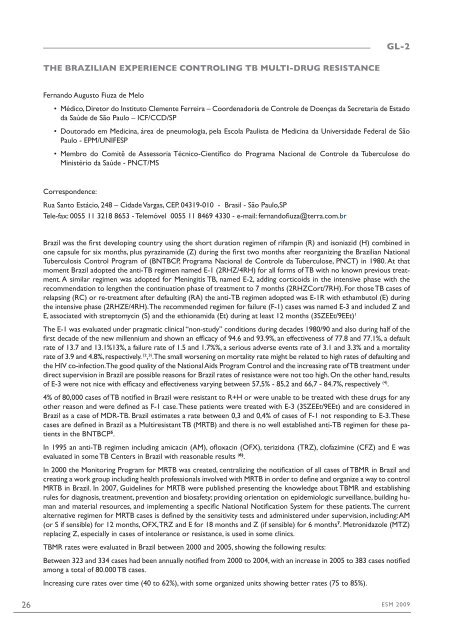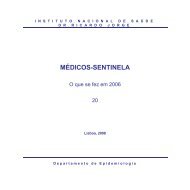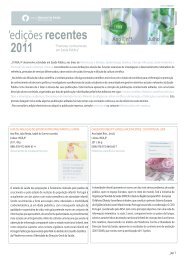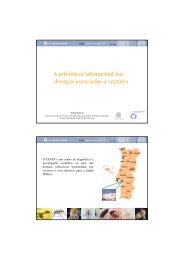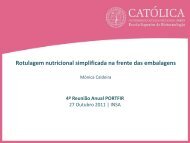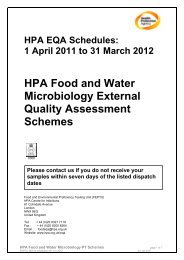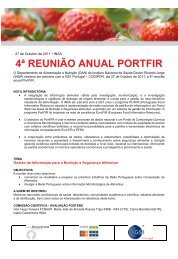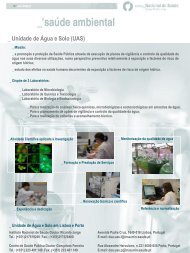European Society of Mycobacteriology - Instituto Nacional de Saúde ...
European Society of Mycobacteriology - Instituto Nacional de Saúde ...
European Society of Mycobacteriology - Instituto Nacional de Saúde ...
You also want an ePaper? Increase the reach of your titles
YUMPU automatically turns print PDFs into web optimized ePapers that Google loves.
GL-2<br />
THE BRAZILIAN EXPERIENCE CONTROLING TB MULTI-DRUG RESISTANCE<br />
Fernando Augusto Fiuza <strong>de</strong> Melo<br />
• Médico, Diretor do <strong>Instituto</strong> Clemente Ferreira – Coor<strong>de</strong>nadoria <strong>de</strong> Controle <strong>de</strong> Doenças da Secretaria <strong>de</strong> Estado<br />
da Saú<strong>de</strong> <strong>de</strong> São Paulo – ICF/CCD/SP<br />
• Doutorado em Medicina, área <strong>de</strong> pneumologia, pela Escola Paulista <strong>de</strong> Medicina da Universida<strong>de</strong> Fe<strong>de</strong>ral <strong>de</strong> São<br />
Paulo - EPM/UNIFESP<br />
• Membro do Comitê <strong>de</strong> Assessoria Técnico-Científico do Programa <strong>Nacional</strong> <strong>de</strong> Controle da Tuberculose do<br />
Ministério da Saú<strong>de</strong> - PNCT/MS<br />
Correspon<strong>de</strong>nce:<br />
Rua Santo Estácio, 248 – Cida<strong>de</strong> Vargas, CEP. 04319-010 - Brasil - São Paulo,SP<br />
Tele-fax: 0055 11 3218 8653 - Telemóvel 0055 11 8469 4330 - e-mail: fernand<strong>of</strong>iuza@terra.com.br<br />
Brazil was the first <strong>de</strong>veloping country using the short duration regimen <strong>of</strong> rifampin (R) and isoniazid (H) combined in<br />
one capsule for six months, plus pyrazinami<strong>de</strong> (Z) during the first two months after reorganizing the Brazilian National<br />
Tuberculosis Control Program <strong>of</strong> (BNTBCP, Programa <strong>Nacional</strong> <strong>de</strong> Controle da Tuberculose, PNCT) in 1980. At that<br />
moment Brazil adopted the anti-TB regimen named E-1 (2RHZ/4RH) for all forms <strong>of</strong> TB with no known previous treatment.<br />
A similar regimen was adopted for Meningitis TB, named E-2, adding corticoids in the intensive phase with the<br />
recommendation to lengthen the continuation phase <strong>of</strong> treatment to 7 months (2RHZCort/7RH). For those TB cases <strong>of</strong><br />
relapsing (RC) or re-treatment after <strong>de</strong>faulting (RA) the anti-TB regimen adopted was E-1R with ethambutol (E) during<br />
the intensive phase (2RHZE/4RH). The recommen<strong>de</strong>d regimen for failure (F-1) cases was named E-3 and inclu<strong>de</strong>d Z and<br />
E, associated with streptomycin (S) and the ethionamida (Et) during at least 12 months (3SZEEt/9EEt)¹<br />
The E-1 was evaluated un<strong>de</strong>r pragmatic clinical “non-study” conditions during <strong>de</strong>ca<strong>de</strong>s 1980/90 and also during half <strong>of</strong> the<br />
first <strong>de</strong>ca<strong>de</strong> <strong>of</strong> the new millennium and shown an efficacy <strong>of</strong> 94.6 and 93.9%, an effectiveness <strong>of</strong> 77.8 and 77.1%, a <strong>de</strong>fault<br />
rate <strong>of</strong> 13.7 and 13.1%13%, a failure rate <strong>of</strong> 1.5 and 1.7%%, a serious adverse events rate <strong>of</strong> 3.1 and 3.3% and a mortality<br />
rate <strong>of</strong> 3.9 and 4.8%, respectively. ( ²,³ ) . The small worsening on mortality rate might be related to high rates <strong>of</strong> <strong>de</strong>faulting and<br />
the HIV co-infection. The good quality <strong>of</strong> the National Aids Program Control and the increasing rate <strong>of</strong> TB treatment un<strong>de</strong>r<br />
direct supervision in Brazil are possible reasons for Brazil rates <strong>of</strong> resistance were not too high. On the other hand, results<br />
<strong>of</strong> E-3 were not nice with efficacy and effectiveness varying between 57,5% - 85,2 and 66,7 - 84.7%, respectively (4) .<br />
4% <strong>of</strong> 80,000 cases <strong>of</strong> TB notified in Brazil were resistant to R+H or were unable to be treated with these drugs for any<br />
other reason and were <strong>de</strong>fined as F-1 case. These patients were treated with E-3 (3SZEEt/9EEt) and are consi<strong>de</strong>red in<br />
Brazil as a case <strong>of</strong> MDR-TB. Brazil estimates a rate between 0,3 and 0,4% <strong>of</strong> cases <strong>of</strong> F-1 not responding to E-3. These<br />
cases are <strong>de</strong>fined in Brazil as a Multiresistant TB (MRTB) and there is no well established anti-TB regimen for these patients<br />
in the BNTBCP 5 .<br />
In 1995 an anti-TB regimen including amicacin (AM), <strong>of</strong>loxacin (OFX), terizidona (TRZ), cl<strong>of</strong>azimine (CFZ) and E was<br />
evaluated in some TB Centers in Brazil with reasonable results (6) .<br />
In 2000 the Monitoring Program for MRTB was created, centralizing the notification <strong>of</strong> all cases <strong>of</strong> TBMR in Brazil and<br />
creating a work group including health pr<strong>of</strong>essionals involved with MRTB in or<strong>de</strong>r to <strong>de</strong>fine and organize a way to control<br />
MRTB in Brazil. In 2007, Gui<strong>de</strong>lines for MRTB were published presenting the knowledge about TBMR and establishing<br />
rules for diagnosis, treatment, prevention and biosafety; providing orientation on epi<strong>de</strong>miologic surveillance, building human<br />
and material resources, and implementing a specific National Notification System for these patients. The current<br />
alternative regimen for MRTB cases is <strong>de</strong>fined by the sensitivity tests and administered un<strong>de</strong>r supervision, including: AM<br />
(or S if sensible) for 12 months, OFX, TRZ and E for 18 months and Z (if sensible) for 6 months 7 . Metronidazole (MTZ)<br />
replacing Z, especially in cases <strong>of</strong> intolerance or resistance, is used in some clinics.<br />
TBMR rates were evaluated in Brazil between 2000 and 2005, showing the following results:<br />
Between 323 and 334 cases had been annually notified from 2000 to 2004, with an increase in 2005 to 383 cases notified<br />
among a total <strong>of</strong> 80.000 TB cases.<br />
Increasing cure rates over time (40 to 62%), with some organized units showing better rates (75 to 85%).<br />
26 ESM 2009


